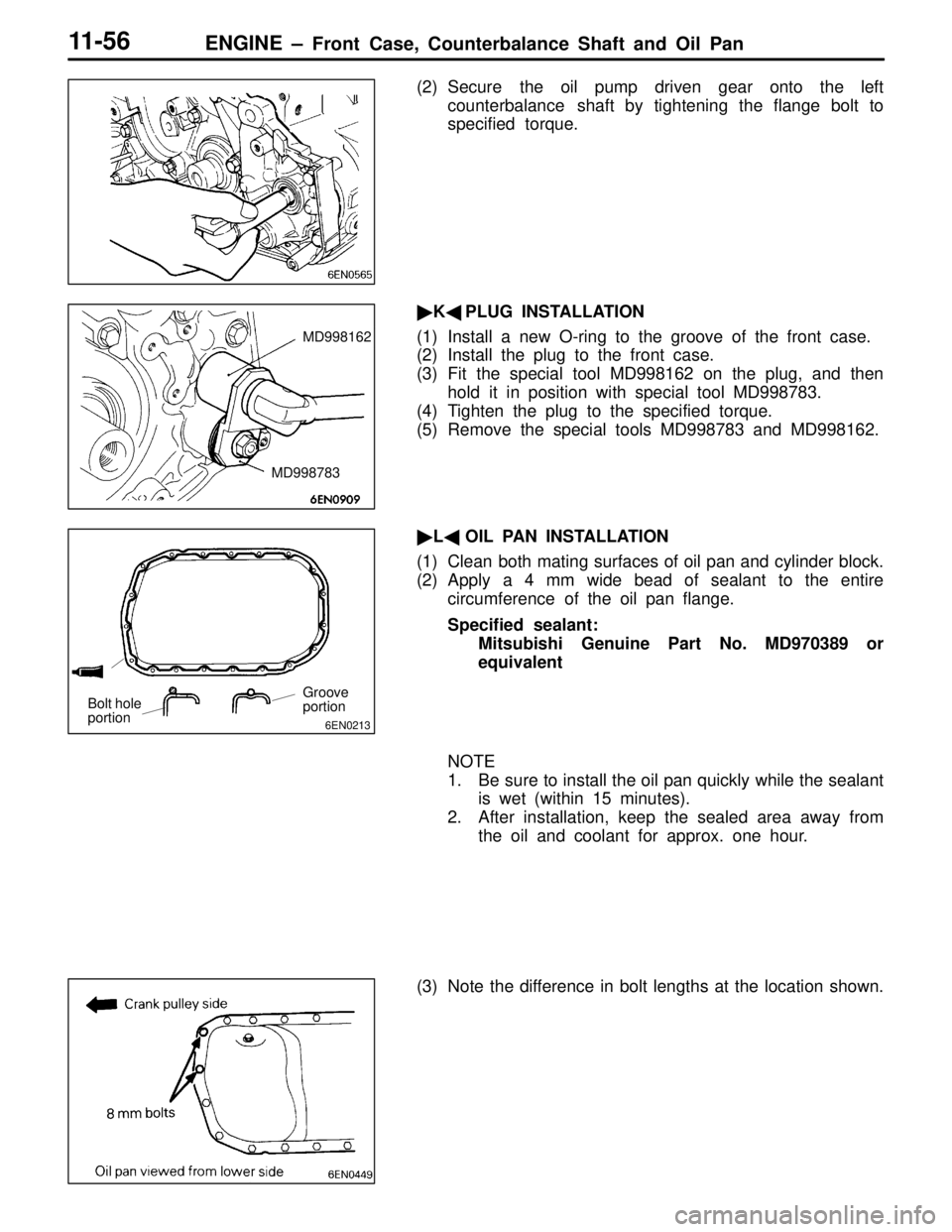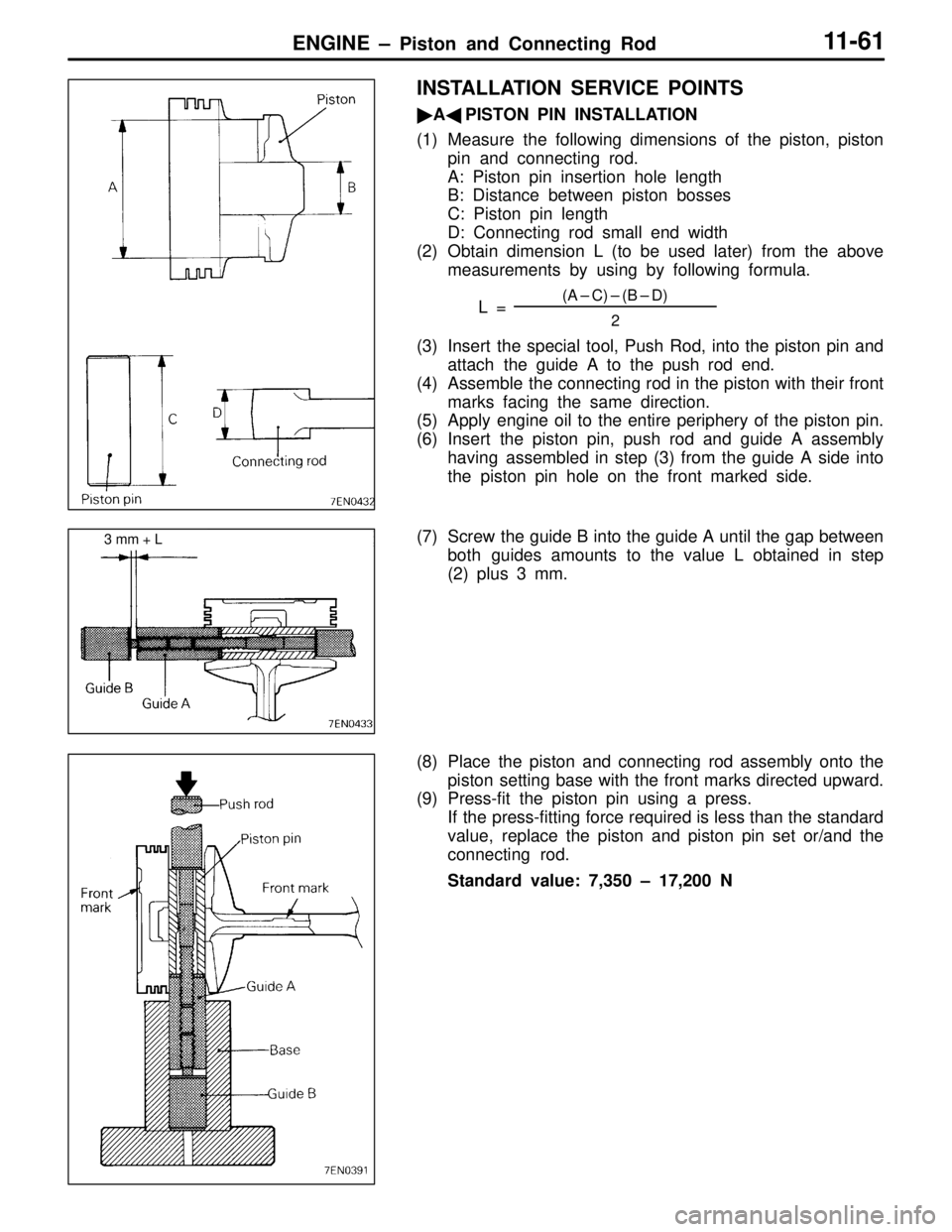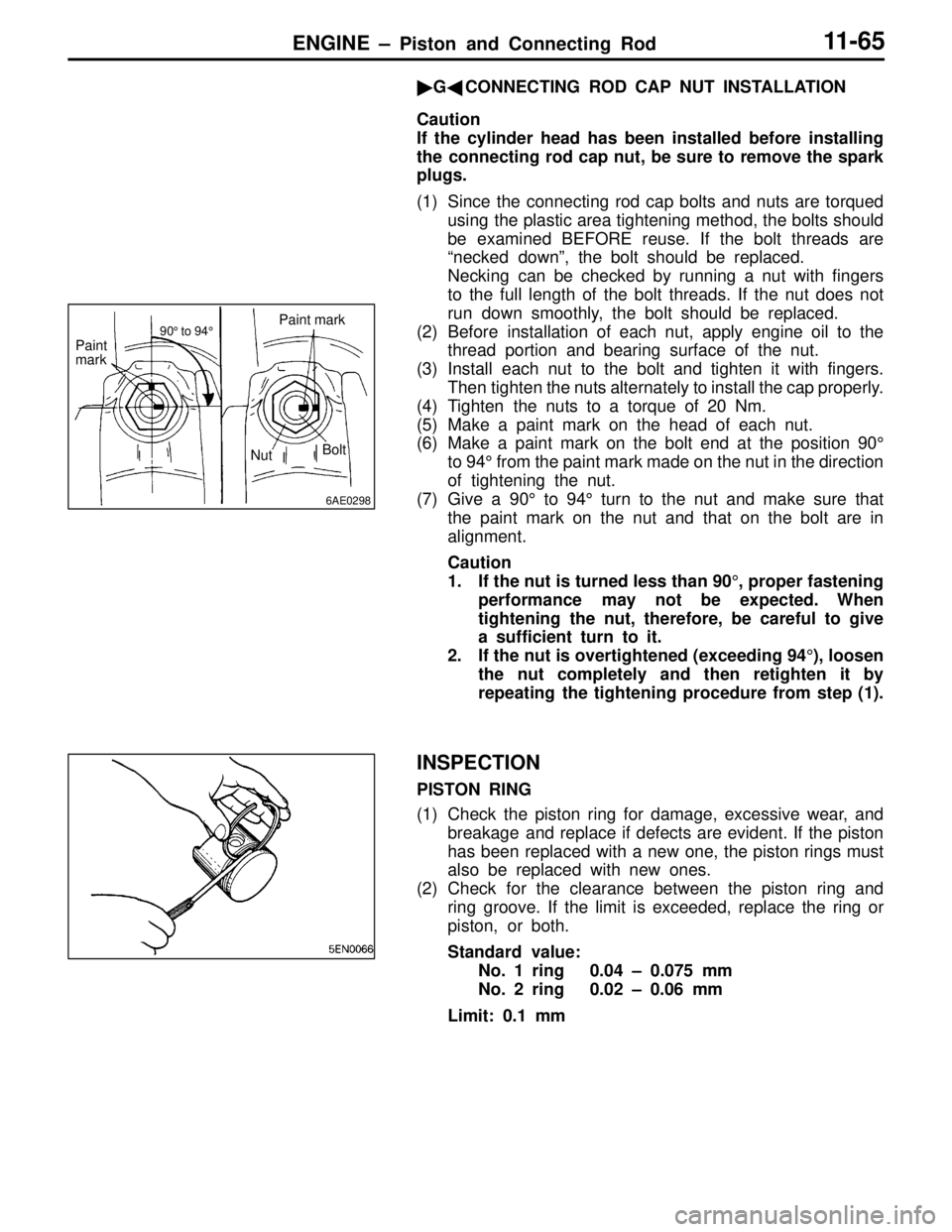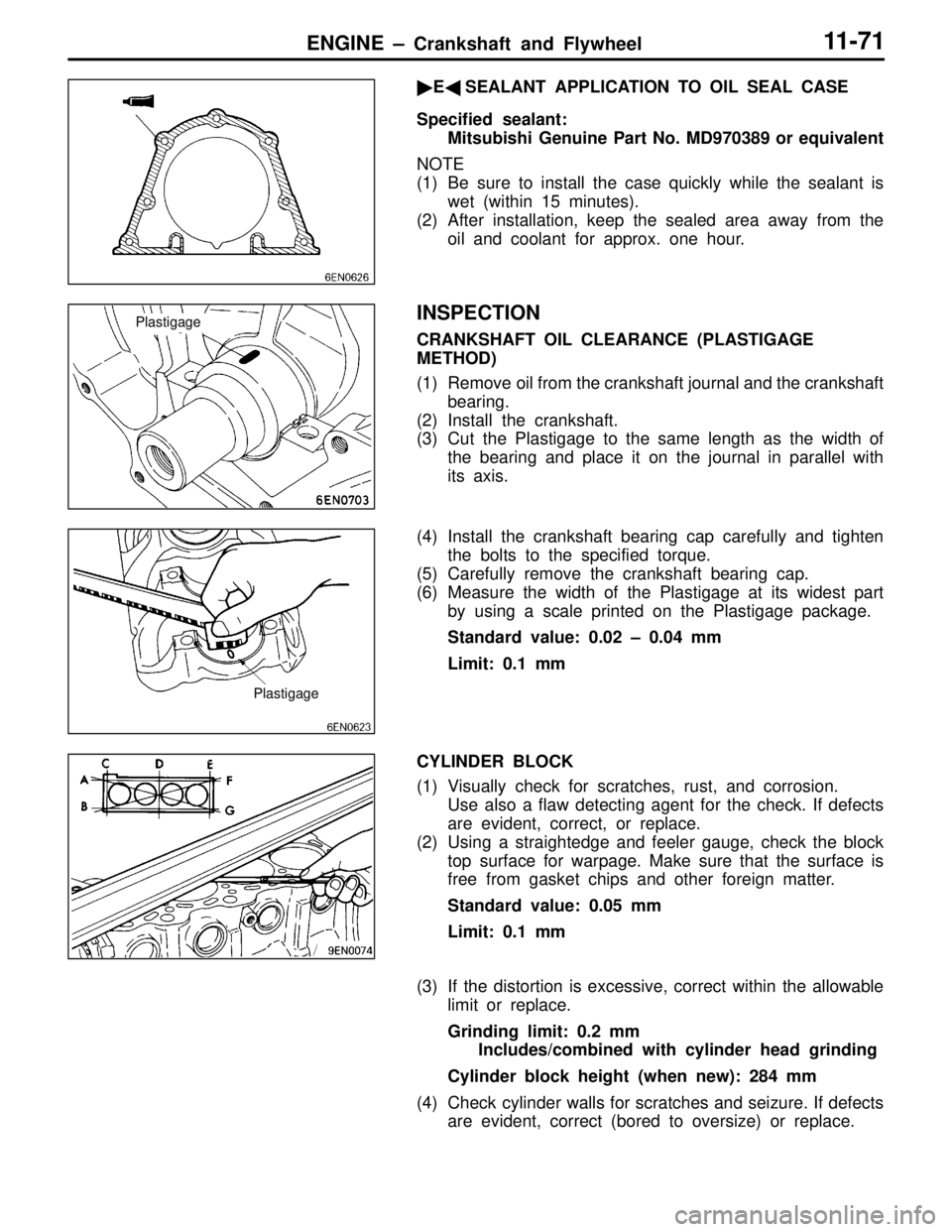Page 75 of 558
ENGINE – Cylinder Head and Valves11-50
VALVE GUIDE REPLACEMENT PROCEDURE
(1) Force the valve guide out toward the cylinder block using
a press.
(2) Machine the valve guide hole in the cylinder head to
the size of the oversize valve guide to be installed.
Caution
Do not use the valve guide of the same size as the
removed one.
Valve gauge hole diameters in cylinder head
ItemStandard value mm
0.05 O.S.12.05 – 12.07
0.25 O.S.12.25 – 12.27
0.50 O.S.12.50 – 12.52
(3) Press-fit the valve guide until it protrude specified value
19.5 mm as shown in the illustration.
Caution
1. Press the valve guide from the cylinder head top
surface.
2. Valve guide for intake valve and that for exhaust
valve are different in length. (45.5 mm for intake
valve; 50.5 mm for exhaust valve)
(4) After the valve guide has been installed, insert a new
valve to check for smooth sliding motion.
1EN0106
Protrusion
Page 81 of 558

ENGINE – Front Case, Counterbalance Shaft and Oil Pan11-56
(2) Secure the oil pump driven gear onto the left
counterbalance shaft by tightening the flange bolt to
specified torque.
�K�PLUG INSTALLATION
(1) Install a new O-ring to the groove of the front case.
(2) Install the plug to the front case.
(3) Fit the special tool MD998162 on the plug, and then
hold it in position with special tool MD998783.
(4) Tighten the plug to the specified torque.
(5) Remove the special tools MD998783 and MD998162.
�L�OIL PAN INSTALLATION
(1) Clean both mating surfaces of oil pan and cylinder block.
(2) Apply a 4 mm wide bead of sealant to the entire
circumference of the oil pan flange.
Specified sealant:
Mitsubishi Genuine Part No. MD970389 or
equivalent
NOTE
1. Be sure to install the oil pan quickly while the sealant
is wet (within 15 minutes).
2. After installation, keep the sealed area away from
the oil and coolant for approx. one hour.
(3) Note the difference in bolt lengths at the location shown.
MD998162
MD998783
6EN0213
Bolt hole
portionGroove
portion
Page 85 of 558
ENGINE – Piston and Connecting Rod11-60
REMOVAL SERVICE POINTS
�A�CONNECTING ROD CAP REMOVAL
(1) Mark the cylinder number on the side of the connecting
rod big end for correct reassembly.
(2) Keep the removed connecting rods, caps, and bearings
in order according to the cylinder number.
�B�PISTON PIN REMOVAL
(1) Insert the special tool, Push Rod, into the piston from
the side on which the front mark is stamped in the piston
head, and attach the guide C to the push rod end.
(2) Place the piston and connecting rod assembly on the
special tool, Piston Pin Setting Base, with the front mark
facing upward.
(3) Using a press, remove the piston pin.
NOTE
Keep the disassembled pistons, piston pins and
connecting rods in order according to the cylinder number.
Page 86 of 558

ENGINE – Piston and Connecting Rod11-61
INSTALLATION SERVICE POINTS
�A�PISTON PIN INSTALLATION
(1) Measure the following dimensions of the piston, piston
pin and connecting rod.
A: Piston pin insertion hole length
B: Distance between piston bosses
C: Piston pin length
D: Connecting rod small end width
(2) Obtain dimension L (to be used later) from the above
measurements by using by following formula.
L =
(A – C) – (B – D)
2
(3) Insert the special tool, Push Rod, into the piston pin and
attach the guide A to the push rod end.
(4) Assemble the connecting rod in the piston with their front
marks facing the same direction.
(5) Apply engine oil to the entire periphery of the piston pin.
(6) Insert the piston pin, push rod and guide A assembly
having assembled in step (3) from the guide A side into
the piston pin hole on the front marked side.
(7) Screw the guide B into the guide A until the gap between
both guides amounts to the value L obtained in step
(2) plus 3 mm.
(8) Place the piston and connecting rod assembly onto the
piston setting base with the front marks directed upward.
(9) Press-fit the piston pin using a press.
If the press-fitting force required is less than the standard
value, replace the piston and piston pin set or/and the
connecting rod.
Standard value: 7,350 – 17,200 N
3 mm + L
Page 87 of 558
ENGINE – Piston and Connecting Rod11-62
(10)Check that the piston moves smoothly
�B�OIL RING INSTALLATION
(1) Fit the oil ring spacer into the piston ring groove.
NOTE
1. The side rails and spacer may be installed in either
direction.
2. New spacers and side rails are colored for
identification of their sizes.
SizeIdentification color
StandardNone
0.50 mm oversizeRed
1.00 mm oversizeYellow
(2) Install the upper side rail.
To install the side rail, first fit one end of the rail into
the piston groove, then press the remaining portion into
position by finger. See illustration.
Use of ring expander to expand the side rail end gap
can break the side rail, unlike other piston rings.
Caution
Do not use piston ring expander when installing side
rail.
(3) Install the lower side rail in the same procedure as
described in step (2).
(4) Make sure that the side rails move smoothly in either
direction.
6EN1237
Lower side railSpacer
Upper
side rail
1EN0269
Side rail gap
Page 90 of 558

ENGINE – Piston and Connecting Rod11-65
�G�CONNECTING ROD CAP NUT INSTALLATION
Caution
If the cylinder head has been installed before installing
the connecting rod cap nut, be sure to remove the spark
plugs.
(1) Since the connecting rod cap bolts and nuts are torqued
using the plastic area tightening method, the bolts should
be examined BEFORE reuse. If the bolt threads are
“necked down”, the bolt should be replaced.
Necking can be checked by running a nut with fingers
to the full length of the bolt threads. If the nut does not
run down smoothly, the bolt should be replaced.
(2) Before installation of each nut, apply engine oil to the
thread portion and bearing surface of the nut.
(3) Install each nut to the bolt and tighten it with fingers.
Then tighten the nuts alternately to install the cap properly.
(4) Tighten the nuts to a torque of 20 Nm.
(5) Make a paint mark on the head of each nut.
(6) Make a paint mark on the bolt end at the position 90°
to 94° from the paint mark made on the nut in the direction
of tightening the nut.
(7) Give a 90° to 94° turn to the nut and make sure that
the paint mark on the nut and that on the bolt are in
alignment.
Caution
1. If the nut is turned less than 90°, proper fastening
performance may not be expected. When
tightening the nut, therefore, be careful to give
a sufficient turn to it.
2. If the nut is overtightened (exceeding 94°), loosen
the nut completely and then retighten it by
repeating the tightening procedure from step (1).
INSPECTION
PISTON RING
(1) Check the piston ring for damage, excessive wear, and
breakage and replace if defects are evident. If the piston
has been replaced with a new one, the piston rings must
also be replaced with new ones.
(2) Check for the clearance between the piston ring and
ring groove. If the limit is exceeded, replace the ring or
piston, or both.
Standard value:
No. 1 ring 0.04 – 0.075 mm
No. 2 ring 0.02 – 0.06 mm
Limit: 0.1 mm
6AE0298
90° to 94°Paint mark
Paint
mark
NutBolt
Page 93 of 558
ENGINE – Crankshaft and Flywheel11-68
INSTALLATION SERVICE POINTS
�A�CRANKSHAFT THRUST BEARING INSTALLATION
(1) Install the two thrust bearing in the number 3 bearing
bore in the cylinder block. For easier installation, apply
engine oil to the bearings; this will help hold them in
position.
(2) The thrust bearings must be installed with their groove
side toward the crankshaft web.
�B�CRANKSHAFT BEARING INSTALLATION
(1) From the following table, select a bearing whose size
is appropriate for the crankshaft journal outside diameter.
Groove
Identification color of crankshaft journal
Bearing bore size
identification mark
Bearing bore
identification
mark
Cylinder inner
diameter size
mark
Rear face of
cylinder block Bottom of
cylinder block No. 1 No. 2No. 3
No. 4No. 5
Page 96 of 558

ENGINE – Crankshaft and Flywheel11-71
�E�SEALANT APPLICATION TO OIL SEAL CASE
Specified sealant:
Mitsubishi Genuine Part No. MD970389 or equivalent
NOTE
(1) Be sure to install the case quickly while the sealant is
wet (within 15 minutes).
(2) After installation, keep the sealed area away from the
oil and coolant for approx. one hour.
INSPECTION
CRANKSHAFT OIL CLEARANCE (PLASTIGAGE
METHOD)
(1) Remove oil from the crankshaft journal and the crankshaft
bearing.
(2) Install the crankshaft.
(3) Cut the Plastigage to the same length as the width of
the bearing and place it on the journal in parallel with
its axis.
(4) Install the crankshaft bearing cap carefully and tighten
the bolts to the specified torque.
(5) Carefully remove the crankshaft bearing cap.
(6) Measure the width of the Plastigage at its widest part
by using a scale printed on the Plastigage package.
Standard value: 0.02 – 0.04 mm
Limit: 0.1 mm
CYLINDER BLOCK
(1) Visually check for scratches, rust, and corrosion.
Use also a flaw detecting agent for the check. If defects
are evident, correct, or replace.
(2) Using a straightedge and feeler gauge, check the block
top surface for warpage. Make sure that the surface is
free from gasket chips and other foreign matter.
Standard value: 0.05 mm
Limit: 0.1 mm
(3) If the distortion is excessive, correct within the allowable
limit or replace.
Grinding limit: 0.2 mm
Includes/combined with cylinder head grinding
Cylinder block height (when new): 284 mm
(4) Check cylinder walls for scratches and seizure. If defects
are evident, correct (bored to oversize) or replace.
Plastigage
Plastigage